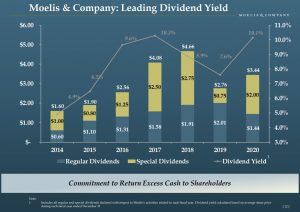Contents

Through this Moelis & Company (MC) stock analysis, I intend to demonstrate why the exclusive use of stock screeners is a poor way to identify investment opportunities.
Rather than rely on stock screeners to make my investment decisions, I use the free version of Finviz solely to help me create a list of companies in sectors and industries I think are attractive.
In the case of MC, I generated a list of companies in the Financial Sector and the Capital Markets industry and refined this list using:
- market capitalization;
- average volume; and
- country metrics
that met my criteria.
I then looked at each company's website and:
- read the most recent 10-Ks, 10-Qs, and the transcripts of recent earnings calls;
- read the recent news;
- reviewed investor presentations; and
- listened to interviews with senior management (members of senior management often participate in conferences and/or are interviewed by the likes of Bloomberg).
This is a time-consuming process but is the bare minimum of research an investor should perform before investing in a company.
Moelis - Stock Analysis - Industry Overview
Within the highly fragmented Financial Services sector is the equally highly fragmented capital markets industry. Within the capital markets space, we have 'bulge bracket' and boutique firms.
'Bulge bracket' is a slang term that describes a company, or companies, in an underwriting syndicate that issues the largest number of securities on a new issue. After the 2008 Financial Crisis, this term has become somewhat outmoded by the practice of referring to investment banks as 'tier one', 'tier two', or 'tier three' investment banks. In conducting my research for this post, however, I continue to hear industry participants still using the term 'bulge bracket'.
'Bulge bracket' firms are typically the first group listed on a tombstone. A tombstone is a written advertisement of a public offering placed by investment bankers who are underwriting an issue. It discloses basic details about the issue and lists each of the underwriting groups involved in the deal.
A comprehensive overview of MC including its Advisory Offering, Key Competitive Strengths, Growth Strategy, and Strategic Alliances is found in Part 1 of the FY2020 10-K.
Further information is provided in this 7.5 minute Bloomberg interview with MC's Chairman and CEO.
Moelis - Stock Analysis - Recent Transactions
Moelis Stands to Benefit from the Evergrande Debacle
This Chinese cash-strapped developer has more than $300B of liabilities and is in the throes of a liquidity crisis. It is racing to raise funds to pay its many lenders and suppliers. Circumstances are so dire the company has communicated to the public that investors interested in redeeming wealth management products for physical assets should contact their investment consultants or visit local offices; an estimated ~$6B in Evergrande wealth management products are outstanding with such products typically held by retail investors.
According to a proposal made by Evergrande, wealth management product investors can choose from discounted apartments, offices, retail space or car parks for repayment. Just recently, for example, Evergrande had outstanding liabilities worth 562 million yuan to a supplier, Skshu Paint Co Ltd., as of the end of August. Evergrande repaid overdue debts to Skshu worth 234.74 million yuan, but 219.5 million yuan of those repayments were in the form of apartments in three unfinished property projects.
While Evergrande's well-publicized dire circumstances are likely to lead some investors to take a much harder look at Chinese investment opportunities, MC stands to benefit from Evergrande's difficulties. It was recently selected by a group of China Evergrande Group bondholders as an adviser on a potential restructuring of a ~$20B tranche of outstanding offshore bonds in the event of non-payment.
Investing in Chinese companies may not appeal to many investors. We can, however, still participate indirectly through investments in well-established North American companies that conduct business with Chinese companies...even if the Chinese companies are not performing well!
Moelis - Stock Analysis - Financials
Q2 2021 and YTD Results
MC released Q2 and YTD results on July 21, 2021. Management does not provide guidance.
A detailed discussion about the results of operations is provided commencing on page 28 of 45 in the Q2 10-Q.
Looking at the Operating expenses we see that Compensation expenses far outweigh non-Compensation expenses. This is not surprising given the nature of the business.
Moelis - Stock Analysis - Credit Ratings
Looking at the Q2 10-Q Balance Sheet, we see that MC has no debt to rate.
MC's Chairman and CEO has extensive industry experience and has witnessed what can happen when there is too much leverage. As a result, the firm's capital structure is such that the firm is unlevered and there is excess capital. In this interview with Bloomberg, Mr. Moelis touches upon the topic of leverage and how 'time is your friend and leverage is the enemy'.
Looking at the historical Consolidated Statements of Cash Flows, we see this is not a capital-intensive business. The largest expense is compensation and benefits and this is directly impacted by the number and size of transactions.
In my opinion, MC's level of risk is totally acceptable for my risk-averse temperament.
Dividend and Dividend Yield
MC's website has no section devoted to the dividend history. This information dating back to mid-2014, however, is available here.
With shares currently trading at $63.23, stock screeners reflect a $0.60 quarterly dividend and a ~3.8% dividend yield. This is not accurate!
MC is committed to returning 100% of excess capital to shareholders and this is achieved through the distribution of regular dividend distributions AND 'special dividends'. On December 29, 2020, and June 18, 2021, for example, MC distributed 'special dividends' of $2.00 and $2.55. These 'special dividends' are excluded from the data within stock screeners.
I have touched upon 'special dividends' in CME Group (CME) and Rollins (ROL) posts; both companies have dividend policies that include the distribution of 'special dividends'.
When MC declared its dividend on April 20, 2020, the firm's Board of Directors deemed it prudent to cut the quarterly dividend by 50% ($0.50 reduced to $0.255) due to uncertain business conditions resulting from the onset of COVID. Looking at MC's dividend history, however, we see the total dividend distributed in FY2020 INCREASED relative to FY2019.
Although the 'special dividend' is unpredictable, MC does have a track record of returning excess capital to investors. In fact, MC has already returned $3.70 to shareholders in FY2021 and at least one more quarterly dividend will likely be declared before FY2021 is over!
With shares trading at ~$63.23, the 2021 YTD dividend yield is ~5.9%. If MC declares another $0.60 quarterly dividend in December, the FY2021 dividend yield will be ~6.9%.
In conjunction with MC's 2014 IPO, it issued Class A and Class B common stock; the publicly traded shares are the Class A shares.
Under MC's equity-based annual compensation process and ongoing hiring process, it offers Restricted Stock and Restricted Stock Units (RSUs). These RSUs generally vest over a service life of four to five years.
While MC does repurchase shares, we see from the FY2018 - FY2020 Consolidated Statements of Cash Flows (page 48 of 83) and the Q2 2021 Condensed Consolidated Statements of Cash Flows (page 7 of 45) that MC issues a far greater number of Class A shares than it repurchases. This is borne out by the increase in the weighted average number of outstanding shares in FY2014 - FY2020: 15.91, 21.36, 24.24, 37.68, 50.69, 55.51, and 60.72 (millions of shares). This increased to 67.15 for the 6 months ending June 30, 2021.
Moelis - Stock Analysis - Valuation
MC has generated YTD adjusted diluted EPS of $2.21 per share.
Although management does not provide guidance, we see from the Q2 earnings release that MC continues to execute on its organic growth strategy. It has:
- Added 11 Managing Directors YTD through internal development and key external hires;
- a strong pipeline of 2021 Managing Director hires; and
- recently announced one additional Managing Director in the U.S. to further expand its capital markets team and strengthen the company's distribution capabilities.
Using the current $63.23 share price and the current FY2021 - FY2023 adjusted diluted EPS broker estimates, we arrive at the following:
- FY2021 - 9 brokers - mean of $4.09 and low/high of $3.72 - $4.40. Using the mean estimate, the forward adjusted diluted PE is ~15.46.
- FY2022 - 9 brokers - mean of $3.74 and low/high of $3.50 - $3.95. Using the mean estimate, the forward adjusted diluted PE is ~16.9.
- FY2023 - 5 brokers - mean of $3.63 and low/high of $3.20 - $4.23. Using the mean estimate, the forward adjusted diluted PE is ~17.4.
Based on the addition of new Managing Directors in FY2021, I would expect estimates from the brokers which cover the firm to be higher than forecast. I am not privy to the methodology the brokers use to derive their forward-adjusted diluted earnings estimates for MC but the estimates reflected above make me wary about initiating a position at this point.
Moelis - Stock Analysis - Return on Invested Capital (ROIC)
Companies largely exist to take capital from investors and to earn a return on this capital. This is why investors should look for businesses with durable competitive advantages that can consistently deliver high returns on invested capital (ROIC).
ROIC is a profitability or performance ratio that aims to measure the percentage return that a company earns on invested capital. It shows how efficiently a company is using investors’ funds to generate income.
Warren Buffett, Berkshire Hathaway’s CEO, repeatedly states that the best business to own is one that over an extended period can employ large amounts of incremental capital at very high rates of return. In Buffett’s 2007 Letter to Shareholders, there is a segment entitled ‘Businesses – The Great, the Good and the Gruesome’ in which Buffett describes the kind of businesses that are appealing and those which should be avoided.
According to Morningstar, MC's 5-year average ROIC is 24.15% versus 14.36% for the index. MC's 5-year average, however, is heavily skewed by the trailing 12 month 50% level and 38.58% in FY2018.
Moelis - Stock Analysis - Final Thoughts
MC is an enticing investment given the attractive ROIC and absence of debt. While the dividend yield (when we include 'special dividends') is impressive, generating additional income is not my focus. I will not, therefore, be initiating a position in MC at this time.
I plan to increase exposure to existing holdings where I think there is a strong potential for superior total long-term investor returns.
Stay safe. Stay focused.
I wish you much success on your journey to financial freedom!
Note: Please send any feedback, corrections, or questions to [email protected].
Disclosure: I am long GS. I do not intend to initiate a position in MC within the next 72 hours.
Disclaimer: I do not know your individual circumstances and do not provide individualized advice or recommendations. I encourage you to make investment decisions by conducting your own research and due diligence. Consult your financial advisor about your specific situation.
I wrote this article myself and it expresses my own opinions. I do not receive compensation for it and have no business relationship with any company mentioned in this article.






